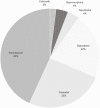Evaluating Adherence of Evidence-Based Post-Operative Discharge Opioid Prescribing Guidelines and Patient Outcomes Two Weeks Post-Discharge
- PMID: 36247825
- PMCID: PMC9562842
- DOI: 10.2147/JPR.S345241
Evaluating Adherence of Evidence-Based Post-Operative Discharge Opioid Prescribing Guidelines and Patient Outcomes Two Weeks Post-Discharge
Abstract
Introduction: There is a growing public health concern regarding inappropriate prescribing practices of discharge analgesia. A tertiary Australian hospital first developed its Postoperative Inpatients Discharge Analgesia Guidelines after an initial audit in 2015. Adherence to the guidelines were evaluated in 2016 and 2017 which show reduced compliance from 93.5% in 2016 to 83.4% in 2017.
Aim: To assess ongoing compliance with the guidelines five years following its implementation and to evaluate patient outcome in terms of its clinical impact and minimization of harmful events.
Methods: Prescribing data were obtained for discharge analgesic medication for 200 surgical patients from August 2019 to April 2020. Records were assessed against the hospital's Postoperative Inpatients Discharge Analgesia Guidelines and compared with equivalent data from the previous 2015, 2016, and 2017 audits. Patients were interviewed by telephone two weeks after hospital discharge.
Results: Prescribing of analgesia was most compliant with overall guidelines for paracetamol (100% unchanged from 2017), followed by celecoxib (98%, up from 96% in 2017), tramadol IR (89% up from 74% in 2017), and pregabalin (89% up from 50% in 2017). Two weeks after discharge, 112 (56%) patients were surveyed and reported a mean pain-score of 2 (95% CI 1.5-2.5) out of 10 at that time. Thirty-two (29%) patients interviewed were still taking pain medication, with 17 (53%) taking medication supplied from the hospital. Seventy-eight (88%) patients stored their pain medication in an unlocked location. Among those no longer taking analgesia, 28 (43%) had unused pain medications, and only two (6%) had returned these to a community pharmacist.
Conclusion: This study found that compliance with hospital discharge analgesia prescribing guidelines has increased, although there is room for improvement. Follow-up of the participants reveals high rates of unused opioids, improper storage and disposal of their pain medication.
Keywords: analgesia; discharge; guidelines; opioid; pain; pharmacotherapy; postoperative; surgery.
© 2022 Arwi et al.
Conflict of interest statement
Gerardo A Arwi and Penelope HR Tuffin have no conflicts of interest to declare. Unrelated to this study, the Anaesthesiology Unit of the University of Western Australia, but not Professor Schug personally, has received research and travel funding and speaking and consulting honoraria from Aspen, Biogen, Foundry, Grünenthal, Indivior, iXBiopharma, Komipharm, Luye Pharma, Mundipharma, Pfizer, Phosphagenics, Pierre Fabre, Seqirus and Xgene within the past three years. Since October 2019, again unrelated to this study, Professor Schug personally has received travel funding, speaking and consulting honoraria from Aspen, ESA, Grünenthal, HealthEd, Seqirus, Therapeutic Guidelines and WAPHA. The authors report no other conflicts of interest in this work.
Figures
References
LinkOut - more resources
Full Text Sources
Miscellaneous






